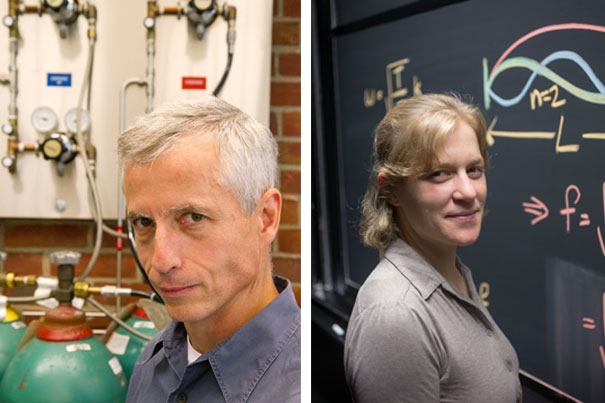
“Jenny Hoffman and Eric Jacobsen epitomize the great teaching that happens in Harvard classrooms every day,” said Dean Michael D. Smith of the Faculty of Arts and Sciences. “Excellent scholars in their different fields, they both share a talent for inspiring their students and instilling in them a passion for science. I hope our colleagues throughout the faculty will join me in congratulating them.”
Jon Chase and Kris Snibbe/Harvard Staff Photographers
Two professors win Fannie Cox Prize
Jacobsen, Hoffman lauded for excellence in teaching science
Eric Jacobsen, the Sheldon Emery Professor of Chemistry, and Jenny Hoffman, an associate professor of physics, have been named recipients of the 2012 Fannie Cox Prize for Excellence in Science Teaching.
The prize recognizes exceptional teaching in introductory courses and carries a $10,000 personal award and $40,000 in unrestricted support for teaching and research. Jacobsen and Hoffman were nominated by a faculty committee, whose members came from across the sciences at Harvard, including previous awardees, and were selected by Jeremy Bloxham, dean of science and Mallinckrodt Professor of Geophysics and professor of computational science.
“Jenny Hoffman and Eric Jacobsen epitomize the great teaching that happens in Harvard classrooms every day,” said Dean Michael D. Smith of the Faculty of Arts and Sciences. “Excellent scholars in their different fields, they both share a talent for inspiring their students and instilling in them a passion for science. I hope our colleagues throughout the faculty will join me in congratulating them.”
Jacobsen has drawn praise from his undergraduate students for “the passion and seriousness with which he taught,” his belief in the “importance of the subject,” and his ability to “instill a deep appreciation for its beauty,” Bloxham wrote in announcing the prize. Jacobsen teaches “Chemistry 17: Principles of Organic Chemistry,” a required course for concentrators in the life sciences.
“Most of the students in Chem 17 don’t plant to be chemists,” Jacobsen said. “It’s not my goal to convert them, but rather to help them see and appreciate the world on a molecular level. I can transmit lots of information to the students, but I need to show why it’s important. … If I don’t do my job well, the students can walk away and not necessarily understand, ‘What is the big question here?’ ”
When Jacobsen began teaching 25 years ago, students admired his blackboard technique. He could write left-handed while erasing with his right hand. But this is the era of Powerpoint and Smart Boards.
“Because of classroom technology, people of my generation are teaching in a way we weren’t taught,” Jacobsen said. “It is a very exciting and challenging time to be involved in classroom teaching.”
In Jacobsen’s research, the big question is, “What is the link between the structure of a molecule and its function?” Jacobsen studies catalysts, which can accelerate the formation and change the distribution of products in chemical reactions much as enzymes do. The Cox award will allow his laboratory to buy new spectrometers for studying these catalysts.
“I feel very fortunate to teach now,” Jacobsen said. “I get to do something I always wanted to do — talk about an exciting field with all these really smart people.”
Hoffman’s students say she is “a fantastic, engaging, and personable lecturer” and is “inspirational and a mentor,” Bloxham wrote. Hoffman teaches “Physics 15C,” a third-semester course known simply as “Waves.”
“When I teach undergraduates, my job is to get them excited and build their confidence,” said Hoffman. “I want them to know that physics is fun, and that they can do it. If they think those things, they will do the learning.”
Hoffman was also awarded a 2012 Roslyn Abramson Award, given annually to assistant or associate professors for excellence in undergraduate teaching.
Hoffman ’99 remembers how as a freshman at Harvard, she assumed she was supposed to do all her problem sets by herself. Her understanding improved once she discovered that she could work with other students. “Science is very collaborative,” Hoffman said. “I set up my classes so students interact with each other a lot.”
Hoffman attributed some of her success to the “flipped classroom” concept advocated by Eric Mazur, Balkanski Professor of Physics and Applied Physics and area dean of applied physics. In flipped classrooms, time is used for interactive learning with peers rather than for lectures.
“The most important teaching happens with students when they are doing, thinking, and learning,” Hoffman said. “Crucial teaching can happen when you can see the students grapple with something and can give [them] immediate, real-time feedback.”
Hoffman sets up her classes so students interact directly with her. She holds evening office hours at campus dining halls, often staying for two or three hours at a time to talk with students about problem sets, graduate schools, and their careers. “More than half the class shows up,” Hoffman said. “It extends the class by two hours a week.”
Hoffman uses plenty of examples from her own research and colleagues’ papers to illustrate principles of waves and oscillations. Hoffman’s lab uses high-resolution scanning probe techniques to understand and control the electronic and magnetic properties of exotic materials, including superconductors and topological materials.
“So far, we have been looking at electron charges, but we are moving toward looking at how the spins of electrons affect the properties of materials,” Hoffman said.
Hoffman is using part of her award to hire another undergraduate to work in her lab. That student will study which etching techniques are best for shaping atomically sharp chromium tips for Hoffman’s lab to use in scanning tunneling microscopy.
“One of the advantages of teaching is that it gives me access to really excellent undergraduates I can tap for lab jobs,” Hoffman said. The student Hoffman is hiring took her class last year.
The Fannie Cox Prize is supported by a gift from Gardner Hendrie ’54.




